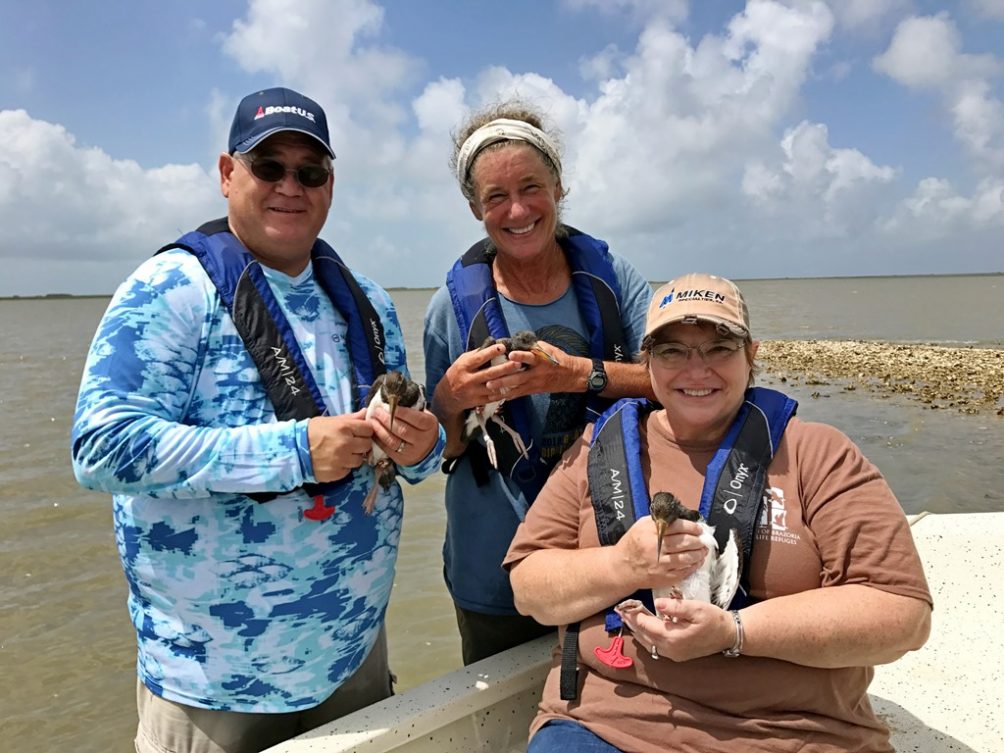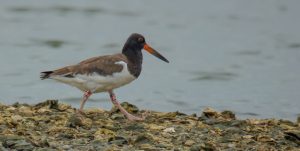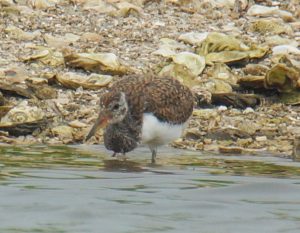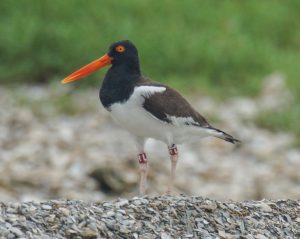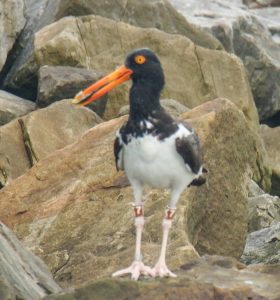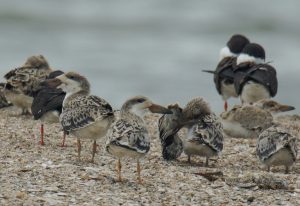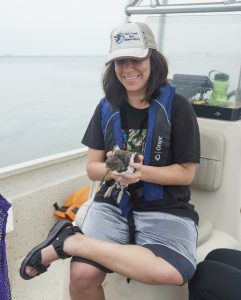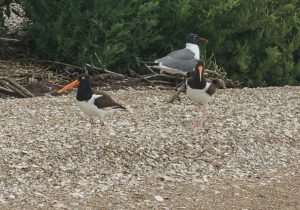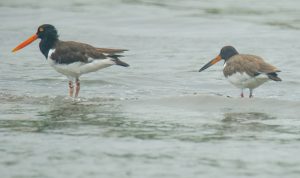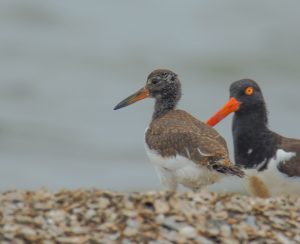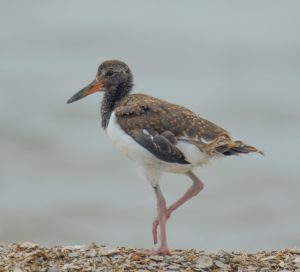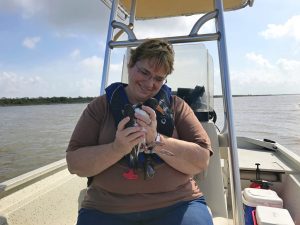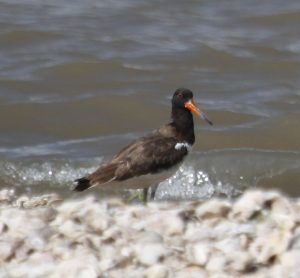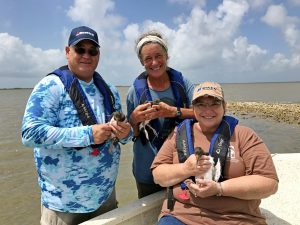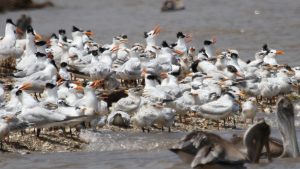By Susan Heath
I was elated to start the week off with an email from one of our volunteers, Oron Atkins, who told me that while out on his regular turtle patrol of Matagorda Peninsula he saw LC & R9 with their chick W0X. We banded W0X in East Matagorda Bay the Friday before Memorial Day weekend and when we checked the week after, the adults and chick were gone. The chick would not have been able to fly at that point so I was afraid something happened to it. Now I know it fledged and is doing well!
The weather caused us to move the regular Wednesday West Galveston Bay to Thursday and I was really glad we did! While we didn’t have any sun, the wind was only about 10 mph which was very nice and we only got hit with a very few raindrops. I headed out West Galveston Bay on Thursday with Alan Wilde, Bev Morrison and GCBO Education Manager Emma Shelly.
I had planned to go up to Swan Lake first but once again the railroad bridge was down and since the tide was high I didn’t want to risk trying to get under it so we headed over to Struve Luci. L8, L9 and their fledged chick were out on a reef. We couldn’t tell if LT & JA were incubating and since the other birds there are done nesting we went to check it out. The eggs were gone and they weren’t acting particularly protective so their nest must have failed. From a distance I saw 12 & unbanded with one chick but last time they had two. What happened to the other one? As we headed around to the other side to check if it was over there we saw HM, X7 & U0U hanging out in their territory. So glad that chick made it!
On the other side we still only saw one chick with 12 & unbanded. Bummer.
The railroad bridge was up so we headed up towards Swan Lake. Nothing much happening up there. 20 & unbanded were sleeping on their island. LR came flying out to greet us when we approached his island and his unbanded mate was standing up on top not budging. It was time for their nest to hatch so perhaps they have a chick. We didn’t see one though.
In Swan Lake proper most of the birds were on the breakwaters and all nesting attempts there appear to be over. L5 was alone again. It appears his mate already left him. On the way out we found 11 & unbanded back on their mud bank. They’ve been missing for a few weeks so it was good to see them again. K7 appeared to be having a feast of some sort.
Back in West Galveston Bay we checked out Jigsaw with its mass of tern and skimmer chicks. They are everywhere! All three pairs of oystercatchers had nests last time we were out and all three were due to be hatched. Sadly it looks like all three failed though. Most of the adults were out on reefs and not acting protective at all. With all those other birds there, it was probably too difficult for them to keep a chick out of trouble. The skimmers appear to be doing well there though.
Then we went over to Galveston Island to check on 16 & unbanded. Last time we were out we discovered they had walked their chick ¼ mile down the shoreline and got it out to reef to keep it safe. Quite a feat. The tide has been pretty high lately so I knew that they would have had to move it back to the mainland. We didn’t see them along the shoreline so we went ashore to check it out. After a bit of searching Emma found the predated body of the chick. It appeared to have happened very recently. Dang. From the looks of the remains, it would have been able to fly in a week. So close. On that somber note, we headed down towards Gangs Bayou.
Things were a little confusing there. There were two pairs on the sandy mounds behind the breakwater and both of them had a banded bird. One of those pairs should have been both unbanded. Alan thought he saw one of them get up off a nest so we had to go around the back side to check it out. On the way we checked for the other two pairs but they weren’t there. When we finally got around to where we could check on the two confusing pairs we discovered one of them was A1A & unbanded. That’s the pair Alan thought had a nest but we couldn’t find one. The other pair was A5A & unbanded. A5A was previously with an unbanded male at the other end of the island. Did A5A leave her mate and move in with a different unbanded male? Since both males are unbanded, we will never know.
From there we checked Confederate Reef but we only found one bird there – XA. We’ve seen this bird on and off all season. It was banded as a chick in 2013 but we’ve not seen it breeding anywhere. It could be a male that hasn’t been able to work its way into a territory yet.
Over on South Deer, all the pairs with fledged chicks were gone except HL & L4 and their chick W3U. They were sleeping on a shell bank in their territory. The two pairs with unfledged chicks (13 & unbanded and Y7 & unbanded) were in their territories with their chicks. It was time to band 13 & unbanded’s chick and fortunately the whole family was sleeping on their beach so we were able to see where the chick ran when we approached. I found it hiding under a shrub. We banded it W2Y.
When we let it go it ran right back to its parents who had been standing by watching us so all was well.
Nothing much was happening on North Deer. The two unbanded pairs on the back side were in place and the fledged chick there was hanging out with its parents. JH and one chick (W3X) were hanging out on a small reef. JR & the other chick were not there.
On Marker 52, it appeared that JJ & P4’s nest and H0 & JC’s nest had both failed. 23 & WY and their chick W0Y were not there. We only saw one chick with 28 & AP but I figured the other one was on the other side of the island and we could check for it when we went into Jones Bay.
We checked on the final pair on North Deer but they weren’t present so I guess their nest failed too. Then we went down the GIWW to check on ET & A8A. Alan and I had both figured their nest must have overwashed since it was basically on a reef. We saw some pelicans standing where it had been and no sign of the oystercatchers. We found them farther down on a reef. Not surprising their nest failed with the tide as high as it has been.
We headed back to Jones Bay then and checked on CA & Y2. They had had a chick on our last trip out but this time they weren’t there so I guess their chick didn’t survive. There are a lot of Caspian Terns and Laughing Gulls nesting there so it’s a tough spot for oystercatchers. We found 28 & AP’s second chick sleeping along the shoreline. It wasn’t with the family so we headed over to check it out. It let us get pretty close before it popped up and ran up to the ridge line. It looked like something was wrong with one of its wings but I couldn’t tell for sure.
It will be time to band them next week so we’ll check it out then. The final pair to check was P3 & unbanded who had two chicks on our last trip out. Today we found them still with two! That was good news but all of the nests that were being incubating on our last trip out had failed which is a bummer. The season is winding down now!
On Friday I headed out to East Matagorda Bay with GCBO Avian Biologist Robin Bjork and GCBO volunteers Keith and Robin Wise. Keith helped me pick out the boat and so it was good to be able to get him out on it. There were four sets of chicks that needed banding but three of them needed banding while I was on vacation last week. I had planned a special trip out this past Monday to band those but the weather was bad Monday and we couldn’t go out. I was hoping maybe we could still catch a few of them.
The first pair we came to was one of the ones with a chick that needed banding last week. I figured it would be able to fly and indeed it could but it was a weak flyer and ended up landing in the water near the island. We waited for it to swim back and then Robin B. and Keith were able to capture it. We banded it W1Y. Here’s Robin Wise holding it.
We headed down the GIWW to Old Gulf Cut where we checked on 17 & unbanded and their chick that fledged a while ago. They were on their island with some Black Skimmers and Gull-billed Terns. There should have been tern and skimmer chicks there too but there were no skimmer chicks and the only tern chicks were those that could fly. Hum. Did the high tide go over the island? The oystercatcher chick was doing well though.
When we got over to the next island where there should have been three oystercatcher chicks with 25 & unbanded, we found only one unbanded adult. Oh no! These were some of the chicks that were ready to be banded last week so there was a chance that they could have already fledged, but like the previous chick they wouldn’t be very strong flyers yet. We searched the other reefs in the area to make sure they hadn’t managed to get over to them. No oystercatcher chicks.
I was suspicious that we hadn’t seen the other adult so I wasn’t ready to give up just yet. The island where they hatched is just inside the bay from Old Gulf cut which goes from the GIWW out into the bay. There are large islands along the GIWW on both sides of the cut and the wind would have been blowing toward them so if the chicks got washed off their hatching island they would have ended up on one of those big islands. We started searching along the shoreline of the nearest big island with our binoculars and sure enough I spotted the other adult over there! We motored a little closer and saw that all three chicks were there with it. Woohoo! We went over to try to catch them to band them and bring them back to the hatching island but all three made a short flight out over the bay, circled around, came back and landed. I guess they weren’t strong enough flyers yet to get back to the hatching island against the wind. I didn’t want to put them at further risk since they were already in a vulnerable spot due to predation of coyotes and pigs on those big islands so we left them alone. Hopefully next week all three will be back on the hatching island.
From there we headed across the bay to the Oyster Farm where there were two more pairs with chicks. The first one was KM & unbanded with two chicks, the last of the bunch that needed to be banded last week. We saw both of them with the adults and when we approached to try to catch them they both flew to another part of the island. No catching them! We moved on to KT & unbanded, the other pair with three chicks. These chicks were a little younger than the others so I was pretty sure they wouldn’t be able to fly yet. We only saw two chicks and Robin B. and Keith made a great chase and caught them both. While we were banding them, somebody spotted the other chick at the end of the island. So there were still three! We were anchored in the middle of the island and I didn’t want to chase the remaining chick from that direction because it would just push it into the water. We finished up with the two we had and then Robin W. held on to them while we motored the boat down to the end of the island where the other chick was. Robin B. and Keith jumped out again and snagged the third chick and we banded it too. Here are my three excellent helpers each with a chick.
Everybody got their exercise today! There wasn’t much else to do after that. We checked on the nest that had been on Dressing Point but the adults weren’t there anymore. I suspect it trampled by all the other birds there. The Royal Terns are doing well there!
KN & A6A came flying out to greet us when we got to their island. I don’t think they like me very much! We checked on W1Y, the first chick we banded and it was happily feeding with its parents so we kept out distance and headed for the boat ramp.
Current Stats for upper Texas coast from Dickinson Bay to East Matagorda Bay: 0 nests being incubated, 58 failed nests, 6 nests with unfledged chicks, 2 nests with undetermined status, 20 chicks fledged
This project is supported by the National Fish and Wildlife Foundation and several private donors. If you would like to contribute you can do that on our website by clicking here! All donations are tax deductible and GREATLY appreciated.
Note: All trapping and banding for this project is in accordance with federal and state permits issued to Susan Heath, GCBO Director of Conservation Research. Bird handling by volunteers is only permitted in the presence of Susan Heath and volunteers are trained in proper bird handling techniques.

